whom they slew and hanged on a tree… (Acts 10:39)
Concerning Attis‘s death, Doane remarks:
Attys, who was cal ed the ―Only Begotten Son‖ and ―Saviour,‖ was worshipped by the
Phrygians…. He was represented by them as a man tied to a tree, at the foot of which was a
lamb, and, without doubt, also as a man nailed to the tree, or stake, for we find Lactantius making
this Apol o of Miletus…say that:
―He was a mortal according to the flesh; wise in miraculous works; but, being arrested by
an armed force by command of the Chaldean judges, he suffered a death made bitter
with nails and stakes.‖130
126 Price, R., 87.
127 Tacey, 110.
128 Acharya, SOG, 281.
129 Higgins, I, 499.
130 Doane, 190-191.
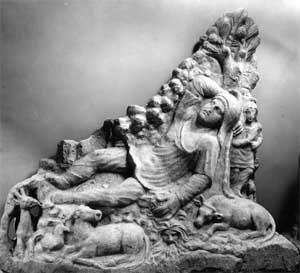
In his book Divine Institutes (4.11), Christian writer Lactantius (c. 240-c. 320) relates that, according to his
oracle, the sun god Apollo of Miletus was ―mortal in the flesh, wise in miraculous deeds, but he was made
prisoner by the Chaldean lawgivers and nailed to stakes, and came to a painful death.‖131 If the oracle
really had recounted a genuinely ancient account of Apollo‘s passion, then we have a pre-Christian
mythical precedent for that of Jesus. Moreover, the identification of Attis with Apollo is apt, since both
were taken in antiquity to be sun gods and discussed together, such as by Macrobius and the Emperor
Julian ―the Apostate‖ (331/332-363 AD/CE), the latter of whom said that both Apollo and Attis were ―closely
linked with Helios,‖132 the older Greek sun god.
Death of Attis
(Archaeological Museum of Ostia, Rome)
Tomb/Three Days/Resurrected: We have already seen Dr. Fear‘s commentary that Attis was dead for
three days and was resurrected, worth reiterating here:
The youthful Attis after his murder was miraculously brought to life again three days after his
demise. The celebration of this cycle of death and renewal was one of the major festivals of the
metroac cult. Attis therefore represented a promise of reborn life and as such it is not surprising
that we find representations of the so-called mourning Attis as a common tomb motif in the
ancient world.133
The death and resurrection in three days, the ―Passion of Attis,‖ is also related by Professor Merlin Stone:
Roman reports of the rituals of Cybele record that the son...was first tied to a tree and then
buried. Three days later a light was said to appear in the burial tomb, whereupon Attis rose from
the dead, bringing salvation with him in his rebirth.134
There is a debate as to when the various elements were added to the Attis myth and ritual. In this regard,
Murdock writes in ―The Real ZEITGEIST Chal enge‖:
Contrary to the current fad of dismissing all correspondences between Christianity and Paganism,
the fact that Attis was at some point a ―dying and rising god‖ is concluded by Dr. Tryggve
Mettinger, a professor of Old Testament Studies at the University of Lund and author of The
Riddle of the Resurrection, who relates: ―Since the time of Damascius (6th cent. AD/CE), Attis
seems to have been believed to die and return.‖ (Mettinger, 159) By that point, we possess clear
discussion in writing of Attis having been resurrected, but when exactly were these rites first
celebrated and where? Attis worship is centuries older than Jesus worship and was popular in
some parts of the Roman Empire before and well into the ―Christian era.‖
131 Lactantius, 245.
132 Athanassiadi, 204.
133 Lane, 39.
134 Stone, 146.
In addition, it is useful here to reiterate that simply because something occurred after the year 1
AD/CE—which was not the dating system used at that time—does not mean that it was influenced
by Christianity, as it may have happened where Christianity had never been heard of. In actuality,
not much about Christianity emerges until the second century, and there remain to this day
places where Christianity is unknown; hence, these locations can still be considered pre-
Christian.
It is probable that the Attis rites were celebrated long before Christianity was recognized to any
meaningful extent. Certainly, since they are mysteries, they could have been celebrated but not
recorded previously, especially in pre-Christian times, when the capital punishment for revealing
the mysteries was actually carried out.
In the case of Attis, we possess a significant account in Diodorus (3.58.7) of his death and
mourning, including the evidently annual ritual creation of his image by priests. Hence, these
noteworthy aspects of the Attis myth are clearly pre-Christian. Although Diodorus does not
specifically state that Attis was resurrected, the priests parading about with an image of the god is
indicative that they considered him risen, as this type of ritual is present in other celebrations for
the same reason, such as in the Egyptian festivities celebrating the return of Osiris or the rebirth
of Sokar….
…although we do not need Attis to show a dying-and-rising parallel to Christ, the material in
ZG1.1 concerning him is soundly based in scholarship. Regardless of when these attributes were
first associated specifically with Attis, the dying-and-rising motif of springtime myths is verified as
pre-Christian by the fact of its appearance in the story of Tammuz as well as that of the Greek
goddess Persephone, also known as Proserpina, whose ―rise‖ out of the underworld was
celebrated in the Greco-Roman world. That the festivals displayed by the Attis myth represent
spring celebrations and not an imitation of Christianity is the most logical conclusion. Indeed, the
presence of such a ritual in springtime festivals dating back to the third millennium BCE, as
Mettinger relates, certainly makes the case for borrowing by Christians, rather than the other way
around.135
Again, the reason these motifs are common in many places is because they revolve around nature
worship, solar mythology and astrotheology.
20.
Krishna, of India, born of the virgin Devaki with a “star in the east” signaling his
coming. He performed miracles with his disciples, and upon his death was
resurrected.
The sun is a prominent deity in the religions of India as elsewhere, dating back centuries to millennia.
Hindu literature from ancient times is full of reverence for the solar deity, the supreme light that inhabits
the visible disk. In the Gāyatrī Mantra, a Vedic scripture, the sun is revealed as the Supreme Godhead:
Let us adore the supremacy of that divine Sun, the Godhead, who illuminates all, who recreates
all, from whom all proceed, to whom all must return: whom we invoke to direct our understanding
aright in our progress toward his holy seat.136
Demonstrating its importance—and that of the sun to Indian religion—this ―mantra of the sun‖ is claimed
to be ―superior to all the mantras referred to in the Vedas.‖137 Indeed, the Gāyatrī is ―considered as the
‗Mother of the Vedas.‘‖138
The main Indian sun god is called Surya, but numerous other deities within the Hindu pantheon also
possess solar attributes and have been deemed sun gods as well. As another solar deity, the Indian god
Krishna‘s story follows a pattern of mythical motifs similar to the Christ myth.139 Krishna‘s solar nature is
135 Murdock, RZC, 15-16, For a discussion of the dating of various aspects of the Attis myth, see Christ in Egypt,
392ff.
136 This text represents an elegant paraphrase of the Gāyatrī Mantra by Indianist Sir William Jones. (See Balfour,
203.)
137 Pathar, 43.
138 Pathar, 43.
139 See Murdock‘s Suns of God: Krishna, Buddha and Christ Unveiled for more information on Krishna‘s solar nature.
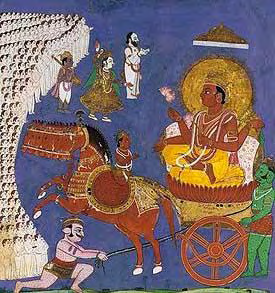
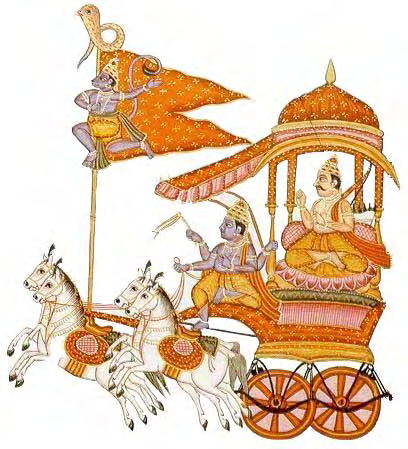
clear from many of his characteristics and adventures, not the least of which is his status as an
incarnation of the god Vishnu. In this regard, Lalta Prasad Pandey remarks that Vishnu‘s solar nature is
―‗beyond doubt‘ and that the Vedas concur that Vishnu was a sun god.‖140 Says Pandey: ―Vishnu,
described in the Rgveda, is another solar deity.‖141
In the Bhagavad Gita, verse 10.21, Krishna states:
I am Vishnu striding among sun gods, the radiant sun among lights...142
Surya in chariot driven by Aruna
Krishna in chariot driven by Arjuna
Just as Jesus was considered an incarnation of God himself, so was Krishna the incarnation of Vishnu in
a miraculous conception. In another sacred Indian text called the Vishnu Purana (5.1-3) we read:
…the supporter of the earth, Vishnu, would be the eighth child of Devakí…
No person could bear to gaze upon Devaki, from the light that invested her, and those who
contemplated her radiance felt their minds disturbed. The gods, invisible to mortals, celebrated
her praises continually from the time that Vishnu was contained in her person.... Thus eulogized
by the gods, Devaki bore, in her womb, the lotus-eyed (deity), the protector of the world....143
Born of a Virgin: Like Krishna, who is essentially a solar deity and not a ―real person,‖ so too is his
mother, Devaki, a mythical figure. Although the story becomes very complicated and far from its roots in
later retellings, the germ of the Krishna-Devaki myth can apparently be found in the Rig Veda, in which
the Dawn goddess gives birth to the rising Sun.144 This miraculous conception of a god incarnating
himself through a ―mortal‖ woman obviously compares to the gospel tale of Jesus‘s nativity.
Even though it is accepted that Krishna was another form of the Divine Vishnu, it is nevertheless argued
that because Devaki had other children prior to the birth of Krishna, she was not ―a virgin.‖ Yet, in
mythology the perpetual virgin is a common motif, regardless of how many children the female is said to
have given birth to. As Carpenter points out:
There is hardly a god whose worship as a benefactor of mankind attained popularity in any of the
four continents...who was not reported to have been born from a virgin, or at least from a mother
who owned the child not to any earthly father.145
140 Pandey, 17; Acharya, SOG, 183.
141 Pandey, 16.
142 Stoler Miller, 94.
143 Wilson, 264, 268.
144 Acharya, SOG, 222.
145 Carpenter, 156.
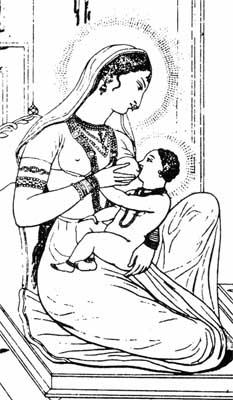
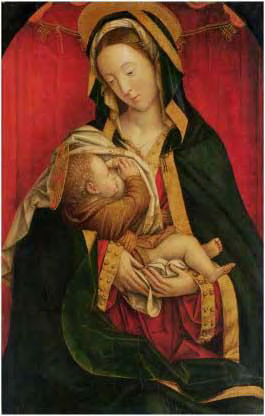
Indeed, the notion of a ―divine birth‖ is common in the ancient literature; although not always the same as
―virgin birth,‖ it is very close, by definition. In the Indian text the Bhagavad Gita (4:9), Krishna tells his
disciple Arjuna about his own ―divine‖ or ―transcendental‖ birth.
Moreover, while Devaki may have had other children, so too is Jesus depicted as having brothers and
sisters. For example, Matthew 12:46 refers to Jesus‘s ―brothers‖:
While he (Jesus) was still speaking to the people, behold his mother and his brothers stood
outside, asking to speak with him.
The scripture at Matthew 13:55-56 reads:
Is not this the carpenter‘s son? Is not his mother called Mary? And are not his brothers James
and Joseph and Simon and Judas? And are not all his sisters with us?
Despite apparently giving birth to all these children, Mary remains a perpetual virgin.146
Regarding this virgin-birth motif, Murdock states:
While the most common terminology concerning the status of Krishna‘s mother, Devaki, when
she gave birth to the god is that she was ―chaste,‖ another myth depicts her becoming a virgin
mother as a teenager after eating the seed of a mango. This apocryphal tale demonstrates that
the notion of the virgin mother existed in Hindu mythology, specifically applicable to Devaki, who
later became Krishna‘s mother. In the Indian epic the Mahabharata, parts of which were
composed centuries before the Christian era, the character Draupadi is a virgin mother, while the
book‘s supposed author, also named Krishna, is said to have been born of a virgin. Also in the
Mahabharata, the goddess Kunti remarks: ―Without a doubt, through the grace of that god, I once
more became a virgin.‖ Kunti is depicted as a ―chaste maiden‖—here unquestionably a virgin—
who is impregnated by the sun god Surya. Other ―born-again virgins‖ in this epic include Madhavi
and Satyavati.147
In consideration of the fact that a number of important figures in the Hindu sacred texts are
unquestionably depicted as virgin mothers—including Devaki as a teenager—it is understandable that
many writers have depicted Krishna‘s birth as virginal. For more on the subject, see Murdock‘s Suns of
God and ―Was Krishna‘s Mother a Virgin?‖
Devaki suckling Krishna
Virgin Mary suckling Christ
(Moor, Hindu Pantheon, pl. 59)
15th century
(Defendente Ferrari)
146 Catholic and other Christian apologists contend that these ―brothers‖ (and sisters) are either Jesus‘s cousins or
the children of Joseph by Mary.
147 Murdock, RZC, 17.
“Star in the East”: Although it is not specifically termed a ―star in the east,‖ in the Indian text the
Bhagavata Purana (10.3:1), a constellation called ―Rohini‖ or ―his stars‖ is present at Krishna‘s birth. As
professor of Hinduism at Rutgers University Dr. Edwin F. Bryant remarks:
At the time of [Krishna‘s] birth, all the constellations and stars were benevolent. The constellation
was Rohini, which is presided over by Brahma.148
Regarding this stellar motif, J.M. Robertson states:
Now, it is a general rule in ancient mythology that the birthdays of God were astrological; and the
simple fact that the Purana gives an astronomical moment for Krishna‘s birth is a sufficient proof
that at the time of writing they had a fixed date for it. The star Rohini under which he was born, it
will be remembered, has the name given in one variation of the Krishna legend to a wife of
Vasudeva who bore to him Rama, as Devaki...bore Krishna. Here we are in the thick of ancient
astrological myth. Rohini (our Aldebaran) is ―the red,‖ ―a mythical name also applied now to
Aurora, now to a star.‖149
The point here is that a celestial portent is common at the birth of great gods, legends, heroes and
patriarchs, as can be found in other stories and myths, including the Persian lawgiver Zoroaster, whose
very name means ―star of splendor,‖150 and Buddha, as the ―immortals of the Tushita-heaven decide that
Buddha shall be born when the ‗flower-star‘ makes its first appearance in the East.‖151 Hence, the story
about the star in the east at Christ‘s birth is an unoriginal and patently mythical motif.
Performed Miracles: Quoting Murdock:
Krishna‘s performance of miracles, in front of his disciples, is legendary, including many in the
Mahabharata, in which he reveals mysteries to his disciple Arjuna (John?). Krishna does likewise
in the Bhagavad Gita, in which he describes himself as the ―Lord of all beings,‖ among many
epithets similar to those found within Christianity. In this same regard, Krishna says: ―I am the
origin of al that exists, and everything emanates from Me.‖152
Death and Resurrection: Concerning Krishna‘s death and ascension, in The Oxford Companion to
World Mythology, Dr. Leeming states:
Just after the war, Krishna dies, as he had predicted he would, when, in a position of meditation,
he is struck in the heel by a hunter‘s arrow. His apotheosis occurs when he ascends in death to
the heavens and is greeted by the gods.153
Regarding the resurrection/ascension, the Mahabharata (4) says that Krishna or ―Keshava,‖ as he is also
traditionally called, immediately returns to life after being killed and speaks only to the hunter, forgiving
him of his actions:
…he [the hunter] touched the feet of [Krishna]. The high-souled one comforted him and then
ascended upwards, filling the entire welkin [sky/heaven] with splendour... [Krishna] reached his
own inconceivable region.154
Concerning Krishna‘s death, Murdock remarks:
Although it is not specifically stated that Krishna ―resurrects‖ upon his death—when he is killed
under a tree—he does ascend into heaven, alive again, since he is considered to be the eternal
God of the cosmos. Krishna‘s death is recounted in the Mahabharata and Vishnu Purana, both
148 Bryant, KS, 119.
149 Robertson, 177.
150 Zoroaster or Zarathustra has been credited with ―prophesying‖ the appearance of the ―star in the east‖ over the
place of the coming savior, as in the Arabic Gospel of the Infancy of the Saviour (10). (Roberts, ANF, VIII, 406.) This
―prophecy‖ is also considered to be the prediction of his own rebirth.
151 The star at Buddha‘s birth is said to be the ―Pushya Nakshatra‖ (Prasad, G., 25.) This episode of the star Pushya
at Buddha's birth is found in the Buddhist texts the Mahāvastu and the Lalita Vistara. (Edmunds, 123.)
152 Murdock, RZC, 17.
153 Leeming, OCWM, 232.
154 Rāya, 12.
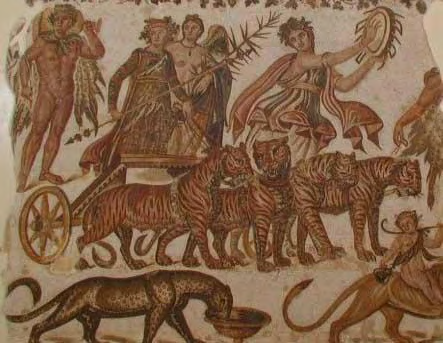
claiming he was killed by a hunter while sitting under a tree, the arrow penetrating his foot, much
like Christ having a nail driven through his feet. In this regard, there have been found in India
strange images of figures in cruciform with nail holes in their hands and feet, one of which was
identified by an Indian priest as possibly the god Wittoba, who is an incarnation of Krishna.155
The impression of a resurrection is evident from the depiction of Krishna comforting his killer just after
death, before he has ascended into heaven. The point is that the god was once dead, but now he is alive
again, whether in this world or the afterlife. This type of detail does not suffice to undermine the fact of the
resurrection or raising up from death being a mythical motif in the first place, applicable both to Christ as
well as many other gods and legendary figures.156
21.
Dionysus of Greece, born of a virgin on December 25th, was a traveling teacher
who performed miracles such as turning water into wine, he was referred to as the
“King of Kings,” “God’s Only Begotten Son,” “The Alpha and Omega,” and many
others, and upon his death, he was resurrected.
It is wise at this point to recall that in the ancient world many gods were confounded and compounded,
deliberately or otherwise. Some were even considered interchangeable, such as Osiris, Horus and Ra. In
this regard, Plutarch (35, 364E) states, ―Osiris is identical with Dionysus.‖157 Thus, Zeus‘s son Dionysus
or Bacchus was considered the Greek rendition of Osiris:
Dionysus became the universal savior-god of the ancient world. And there has never been
another like unto him: the first to whom his attributes were accredited, we call Osiris: with the
death of paganism, his central characteristics were assumed by Jesus Christ.158
Dionysus is likewise identified with the god Aion and also referred to as ―Zeus Sabazius‖ in other
traditions.159 Hence, we would expect him to share in at least some of all these gods‘ attributes.
Dionysus returns from India
Mosaic pavement, 3rd cent. AD/CE
Sousse, Tunisia
(Patrick Hunt)
December 25th (Winter Solstice): As with Jesus, December 25th and January 6th are both traditional birth
dates related to Dionysus and simply represent the period of the winter solstice. Concerning these dates,
Murdock remarks:
155 Murdock, RZC, 17.
156 For more information on the mythical motif of the resurrection, see Murdock, CIE, 402-420.
157 Plutarch/Babbitt, 85.
158 Larson, 82.
159 Graves, R., WG, 335.
The winter-solstice date of the Greek sun and wine god Dionysus was originally recognized in
early January but was eventually placed on December 25th, as related by Macrobius. Regardless,
the effect is the same: The winter sun god is born around this time, when the [shortest day of the
year] begins to become longer….160
Murdock also says:
The birthday of Dionysus can be listed on both the 5th and 6th of January, while the god Aion who
is born on January 6th is called by Joseph Campbell a ―syncretistic personification of Osiris.‖
Dionysus was likewise identified with both Aion and Osiris in ancient times. In antiquity too, Jesus
Christ‘s nativity was also placed on the 6th or 7th of January, when it remains celebrated in some
factions of the Orthodox Church, such as Armenia, as well as the Coptic Church. Concerning
these dates, Christian theologian Dr. Hugo Rahner remarks:
As to the dates, Norden has shown that the change from January 6 to December 25 can
be explained as the result of the reform introduced by the more accurate Julian calendar
into the ancient Egyptian calculation which had fixed January 6 as the date of the winter
solstice.
It thus appears that in ancient times these dates of January 5, 6 and 7 represented the winter
solstice, which is fitting for sun gods. Indeed, Macrobius later places Dionysus‘s birth on
December 25th, again appropriate for a sun god.161
Jesuit theologian Dr. Rahner further states:
...in the Hellenistic East, and with Alexandria evidently taking the lead, a mystery was enacted
that concerned the birth of Aion by a virgin and that this mystery took place on the night leading to
January 6. It is quite immaterial whether the object of the cult in question was really Dionysus
Aion or some other deity. Epiphanius, quoting other ancient writers, tells us elsewhere that the
birthday of Dionysus was celebrated on January 5 and 6, though in the present instance it may
well have been that of Osiris or Harpocrates-Horus. It matters very little, since the tendency in
these late Hellenistic days was for the identities of gods, all of whom were beginning to take on
the character of a solar deity, to become merged with one another. We know that Aion was at this
time beginning to be regarded as identical with Helios and Helios with Dionysus…162
The pertinent passage in the writings of Church father Epiphanius mentioned by Rahner relates:
On this day, i.e. on the eighth day before the Calends of January, the Greeks...celebrate a feast
that the Romans call Saturnalia, the Egyptians Cronia and the Alexandrines Cicellia. The reason
is that the eighth day before the Calends of January forms a dividing-line, for on









